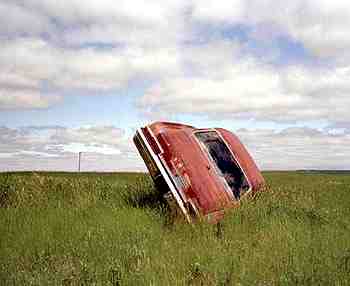EASY RIDER – TRAVELS THROUGH AMERICAN PHOTOGRAPHY PART 1
September 6th, 2008 adminNow that my journey across England is nearing an end, I wanted to look at the notion of the road trip in photography. While I’ve already touched on the timeline of British photographers who have used the road trip as a vehicle for documenting England/Britain, I want to now turn my attention to the work of American photographers. I’ll do this over several blog entries (I will look at European photographers in a future post).
Highway culture has long been a quintessential part of American identity and is also reflected in the canon of contemporary American photography who have worked within the tradition of the road trip across America. Names such as Jeff Brouws, Tim Davis, William Eggleston, Mitch Epstein, Robert Frank, Lee Friedlander, Todd Hido, Dorothea Lange, Ed Ruscha, Lise Sarfati, Stephen Shore, Rosalind Solomon, Alec Soth, Mark Steinmetz, Joel Sternfeld, and Garry Winogrand and others, have all embraced the genre. Several of whom have been major influences in my own work (particularly in Motherland), notably the work of Stephen Shore and Joel Sternfeld.
By way of an introduction to the genres I’m posting up details of an exhibition that was held at the Yancey Richardson Gallery last summer called Easy Rider: Road Trips Through America, which focussed on the road trip in American photography.
Jeff Brouws, Route 248, Four Buttes, Montana, 2004
The following text is taken from the Easy Rider exhibition press release-
“Easy Rider explores the common themes of social commentary, cultural geography and photographic biography produced by the marriage between the road and photography. Included are photographs and videos dating from 1935 to 2006.
The road allowed Farm Security Administration photographers Dorothea Lange and Walker Evans to document the plight of Americans suffering floods and dustbowls during the Great Depression. Similarly bleak, Robert Frank’s mid 1950s road trips yielded a portrait of the nation at odds with the projected optimism of the era and culminated in The Americans, a landmark publication, which influenced generations of later photographers.
The open road as a symbol of freedom is exemplified in Allen Ginsberg’s 1964 shot of Neal Cassady at the wheel of Ken Kesey’s Merry Prankster bus; Cassady’s incessant cross-country journeys were a primary inspiration for Jack Kerouac’s definitive Beat generation novel On the Road. Having spent four years riding with the motorcycle gang the Outlaws, Danny Lyons produced the book The Bikeriders, which emblazoned motorcycle counterculture onto the American psyche and inspired the film Easy Rider.
Subsequent generations of photographers continued to take to the road in order to explore the cultural landscape. Traveling on a 1969 Guggenheim to study the effect of the media on public events, Garry Winogrand recorded America’s restlessness through its political rallies, peace demonstrations and space shuttle launches. In the 1970s Mitch Epstein looked at recreation across America while Joel Sternfeld’s wryly-funny photographs often showed man at odds with nature. Alec Soth followed the watery artery of the Mississippi River to make pictures of the dreams; both lost and fiercely held, of those he encountered. More recently, Tim Davis traveled the country to seek out the presence of politics in today’s life; in St. Louis he found a wall mural of the United States depicted as one grotesquely stretched red state.
Several photographers have looked closely at the details and detritus of American culture for clues to its soul. William Eggleston’s photograph of an elegantly wallpapered restaurant wall plastered over with the business cards of its patrons shows commercial aspirations trumping style. On the bare chipboard walls of Reverend and Margaret’s Bedroom, Soth memorializes a moving display of family photographs while Lisa Kereszi’s discovery of a biker bar’s photographic collage of women flashing their breasts reveals the misogynist underbelly of road-worshipping motorcycle culture.
Many photographers have constructed a kind of biography of roads traveled, places visited and people encountered, often including themselves and family m embers. In 1962, Ed Ruscha photographed isolated gas stations along Route 66 filling half the picture frame with the street at his feet. Lee Friedlander frequently incorporated himself into his car images, staring into the camera through the windshield or via the side view mirror. In his witty series America and Me, recent Bard graduate William Lamson photographed himself interacting with elements of the roadside landscape, always hiding his face but freely revealing the shutter release. Poolside at a roadside inn, Stephen Shore incorporated his young wife Ginger into a minimalist composition of color and light. Accustomed to working on the road, Justine Kurland adjusted to motherhood by photographing her young son living with her in a camper van on an extended road trip.
Jeff Brouws has made a career of photographing along highways, evolving from cataloguing the relics of small town roadside architecture to documenting the negative impact of thruways in the 21st century. His 2004 image of a rusting red car upended in a field presents a pessimistic view of contemporary road culture: the car as a dinosaur on the road to nowhere.”
My subsequent posts will look at the work of individual photographers.


